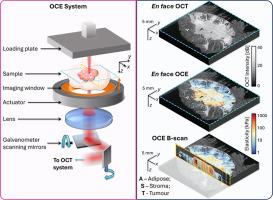利用光学相干弹性成像技术对癌症的微观力学特性进行成像
IF 4.2
3区 工程技术
Q2 ENGINEERING, BIOMEDICAL
引用次数: 0
摘要
光学相干弹性成像(OCE)是一种在微观尺度上表征和绘制癌症力学特性的重要技术。本文综述了肿瘤OCE的最新进展,重点介绍了肿瘤机械生物学、药物传递监测和临床诊断三个最有前景的领域。关键的技术创新包括开发新的加载方法,使单细胞成像,以及成像探针的设计,使OCE应用于体内成像。我们还提供了我们对这些发展如何影响OCE在肿瘤学中的未来翻译和采用的观点。本文章由计算机程序翻译,如有差异,请以英文原文为准。

Imaging the microscale mechanical properties of cancer using optical coherence elastography
Optical coherence elastography (OCE) is emerging as an important technique in characterising and mapping the mechanical properties of cancer on the microscale. This review presents the latest advances in the development of OCE for oncology, highlighting cancer mechanobiology, drug-delivery monitoring and clinical diagnostics as the three most promising areas. Key technical innovations are described including the development of novel loading methods to enable the imaging of single cells, as well as the design of imaging probes that enable OCE's application to in vivo imaging. We also provide our perspective on how these developments may shape future translation and adoption of OCE in oncology.
求助全文
通过发布文献求助,成功后即可免费获取论文全文。
去求助
来源期刊

Current Opinion in Biomedical Engineering
Medicine-Medicine (miscellaneous)
CiteScore
8.60
自引率
2.60%
发文量
59
 求助内容:
求助内容: 应助结果提醒方式:
应助结果提醒方式:


